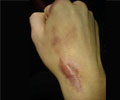Manuka honey might prove handy to treat chronic wound infections and even prevent them from developing in the first place, suggest researchers.

Researchers at Cardiff Metropolitan University have shown that manuka honey can not only destroy fully-formed S. pyogenes biofilms in vitro but also prevent the bacteria initially binding to components of wound tissue.
Honey has long been acknowledged for its antimicrobial properties. Traditional remedies containing honey were used in the topical treatment of wounds by diverse ancient civilisations.
Manuka honey is derived from nectar collected by honeybees foraging on the manuka tree found growing in New Zealand and parts of Australia. It is included in modern licensed wound-care products around the world.
Manuka honey has been reported to inhibit more than 80 species of bacteria, yet the antimicrobial properties of honey have not yet been fully exploited by modern medicine, as its mechanisms of action are not fully understood.
Wounds that are infected with S. pyogenes often fail to respond to treatment. This is largely due to the development of biofilms, which may be difficult for antibiotics to penetrate - in addition to problems of antibiotic resistance.
Advertisement
The latest study reveals that honey can disrupt the interaction between S. pyogenes and the human protein fibronectin, which is displayed on the surface of damaged cells.
Advertisement
"We found that honey reduced the expression of these bacterial surface proteins, inhibiting binding to human fibronectin, therefore making biofilm formation less likely. This is a feasible mechanism by which manuka honey minimizes the initiation of acute wound infections and also the establishment of chronic infections," Dr Maddocks added.
Ongoing work in Dr Maddocks' lab is investigating other wound-associated bacteria including Pseudomonas aeruginosa and meticillin-resistant Staphylococcus aureus (MRSA). Manuka honey has also been shown to be effective at killing these bacteria.
The finding has been published in Microbiology.
Source-ANI










